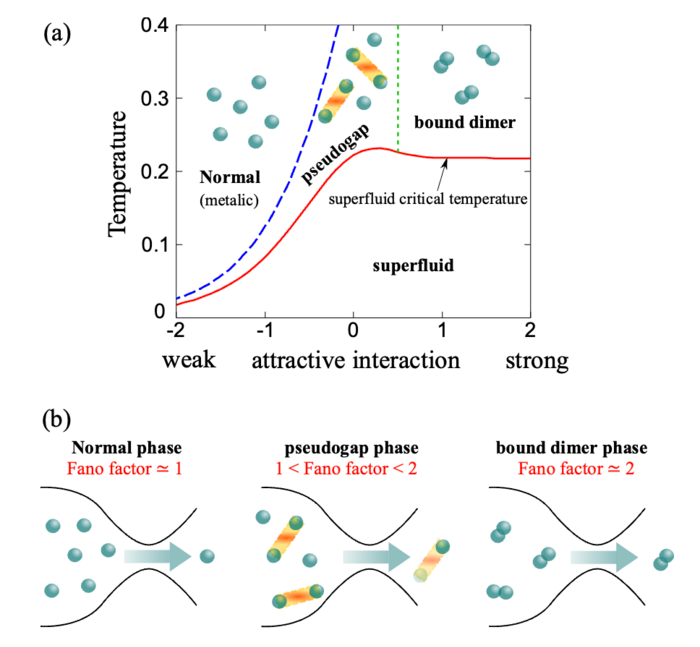A new state of matter known as the Bose-Einstein Condensate (BEC) is achieved by cooling low-density atomic gas to extremely low temperatures (–273 °C). Two-atom molecules that are strongly coupled in a BEC behave like a collective wave in accordance with quantum mechanics.

The vertical axis is the temperature divided by the Fermi temperature, and the horizontal axis is the attractive interaction strength. The red solid curve shows the superfluid critical temperature. The blue dashed line shows characteristic temperatures between normal and pseudogap phases. The green dotted line shows the characteristic temperatures between pseudogap and bound dimer phases. (b) Schematics for the tunneling transport process in the normal phase, the pseudogap phase, and the bound dimer phases. The Fano factor, the ratio between the current noise and the current, helps us distinguish pair-current and single-particle current. Image Credit: Tajima et. al. 2023
Now, according to the Nobel Prize-winning Bardeen-Cooper-Schrieffer (BCS) theory, the atoms produce “Cooper-pairs” if the pairing strength between them is diminished, such as by increasing the magnetic field.
BCS-BEC crossover is the name of this process. Furthermore, the idea serves as the foundation for superfluids and superconductors, materials devoid of viscosity or electrical resistance.
A new method to identify current carriers in the BCS-BEC crossover was presented by Hiroyuki Tajima and his colleagues from the University of Tokyo.
Readings from an electronic device are facilitated by electrons moving in a conductor, also known as single-particle current. Electron collisions in the conductor that release heat as a result of the resistance they produce could cause the device to become hot.
Superconductors, on the other hand, exhibit zero resistance to the current flow and hence conserve a significant amount of energy. Due to their negative charge, paired electrons make this feasible because they would otherwise resist one another.
In other words, rather than being caused by a single-particle current carrier, the current in superconductors is mostly caused by pair-tunneling transport, which involves moving paired-current carriers.
Tajima and his team used an ultracold Fermi atomic gas to study the quantum transport phenomena. It is an artificial quantum system with configurable interaction strength that resembles an electron or fermion system.
To understand non-trivial transport, we need to distinguish whether single-particle tunneling or pair tunneling is dominant in strongly interacting gas. The identification of single-particle tunneling and pair tunneling is vital for understanding quantum transport not only in cold atomic systems but also in high-temperature superconductors.
Hiroyuki Tajima, Assistant Professor, Department of Physics, University of Tokyo
The atomic gas provided the opportunity for systematic investigation of quantum many-body physics since the interactions between particles could be controlled. When the atomic interactions are weak, the gas exhibits a normal phase.
During this stage, it acts like a metal that exhibits electrical resistance but is a reasonably good conductor. With a chemical potential bias (voltage), one can anticipate a single-particle current (electron tunneling transport).
The gas transitions to the bound dimer phase via an intermediary pseudogap phase when the contact intensity is increased. At low temperatures, the BCS-BEC crossover takes place during the pseudogap phase.
The atomic gas transforms into a superfluid state with no viscosity at a certain temperature for a specific interaction strength. Cooper pairs develop below the phase transition temperature and generate a pair current.
In the pseudogap phase, attractive interactions result in the formation of non-superfluid Cooper pairs, which causes an anomalous current in this area. On the other hand, pair current predominates in the bound dimer phase. By measuring an observable macroscopic feature, Tajima’s team was able to discriminate between the current carriers in each phase.
The researchers demonstrated that in a tunneling transport of highly interacting Fermi gases, current fluctuations, measured as the Fano factor, could differentiate between single-particle and pair currents.
For single-particle current, the Fano factor is 1, while for pair current, it is 2. Future applications of their method include other many-body phenomena occurring in cold atoms and other non-conventional superconductors.
Tajima added, “The researchers demonstrated that in a tunneling transport of highly interacting Fermi gases, current fluctuations, measured as the Fano factor, could differentiate between single-particle- and pair-currents. For single-particle current, the Fano factor is 1, while for pair current, it is 2. Future applications of their method include other many-body phenomena occurring in cold atoms and other non-conventional superconductors. This collaboration happened completely through online discussions, which surprisingly enabled us to exchange interdisciplinary knowledge, resulting in this research.”
Journal Reference
Tajima, H., et al. (2023) Nonequilibrium noise as a probe of pair-tunneling transport in the BCS–BEC crossover. PNAS Nexus. doi:10.1093/pnasnexus/pgad045.